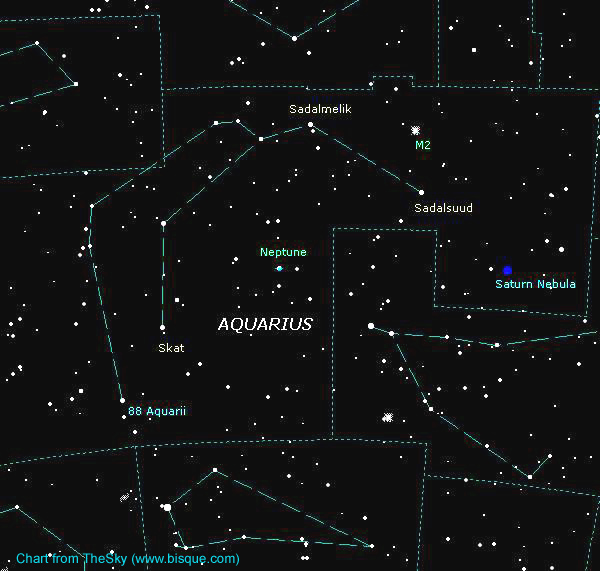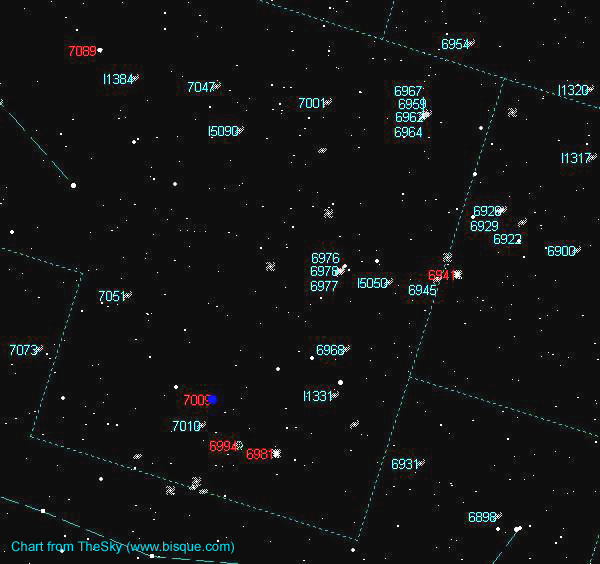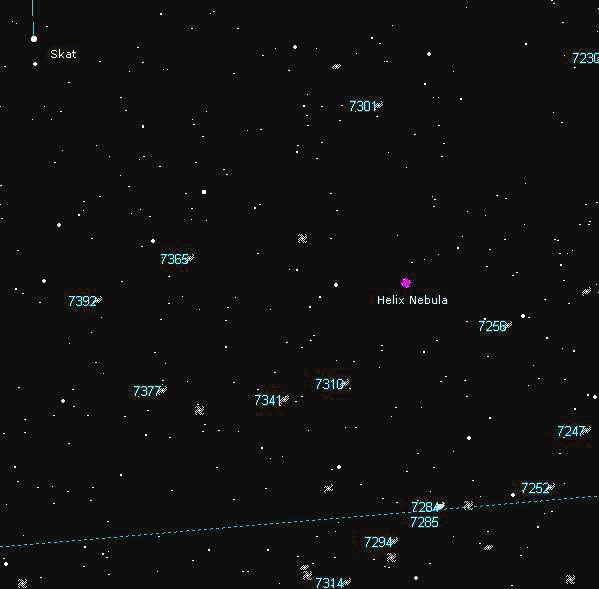The Water Bearer
Aquarius the Water Bearer is one of the original forty-eight constellations catalogued by Ptolemy in the 2nd century. Today, there are eighty-eight modern constellations as determined by the International Astronomical Union. Sometimes referred to as the “Cup-Bearer”, Aquarius is found in the southern part of the sky and measures a little less than 1,000 square degrees in area. The brighter stars that make up the asterism range in magnitude from 3.1 to 4.5, so Aquarius can be seen from the suburbs. Aquarius is also part of the ‘watery’ constellations along with Pisces – The Fishes, Cetus – The Sea Monster and Eridanus – The River.
One of the most interesting objects within the constellation’s boundaries is the Helix Nebula. Officially catalogued NGC 7293 as well as Caldwell 63 the Helix spans almost the entire width of the full moon. At a mere distance of 450 lights years, the Helix is considered the closest planetary nebula to us. With this in mind, the Hubble Space Telescope had to take multiple images and digitally stitch them together to produce its stunning portrait.

When its central star exhausted its fuel some 12,000 years ago, vast amounts of material was cast off into space to form the envelope of material we see today. Hubble’s sensitive instruments reveal the delicate inner ring sporting the cometary knots. To locate the Helix, first, focus your scope on the fifth magnitude star 47 Aquarii. From this K-class orange giant sun, move two degrees east till you come across your magnitude 7.3 target. Another gem to look for is the Saturn Nebula. NGC 7009 is an irregular planetary nebula with a Saturn like disk and the appearance of edge-on rings. The nebula is located 2,400 light-years from us and glows at 8th magnitude.
We will now move to a distant and challenging object. From the third magnitude star called Skat nudge your scope three and a third degrees to the east until you happen upon a faint cluster. Dark skies and a moderate scope are required to catch the globular cluster NGC 7492. Globular clusters are usually easy to nail down and enjoy because of their compressed centre, however, NGC 7492 is an outlying globular that measures a staggering 84,000 light-years from us. The cluster is thought to be some 200 light-years wide with a very loose association of stars and no dense concentration towards the middle. Even though the overall magnitude is 11.3, individual stars are difficult to resolve with the brightest members being in the 15th magnitude range.

Now of the other side of the coin, we have M2 which is a highly resolved globular cluster. At magnitude 6.5, it is just beyond naked-eye detection and you will need some sort of optical aid. M2 lies 37,000 light-years thus residing on the back half of our Milky Way Galaxy, past the nucleus. The cluster’s diameter works out to be 175 light-years wide and is home to an estimated 150,000 stars. M2 measures sixteen arc minutes wide or half that of the full moon. Locating this target is fairly easy. First, go to the bright star Sadalsuud at the northern section of the constellation. From this magnitude 2.9 sun, proceed almost five degrees north.
There are numerous galaxies to hunt and observe. For a faint galaxy challenge, might I suggest Hickson 88. This chain of three galaxies being NGC 6978, 6977 and 6976 also team up with MCG-01-53-014. They range in magnitude 13.2 to 14.8. Large instruments and dark conditions would be a must for this challenge. While you are still in Aquarius, you can find the eight planets of our solar system. Drawing a line between Skat and Sadalsuud, the fuzzy-looking bluish dot is located not quite halfway up the line. Neptune is a gas giant the slowly orbits the Sun in 165 Earth years. Its distance from Earth is 29 astronomical units or 4.3 billion kilometres. At that distance, lights takes a little more than four hours to reach us.

While enjoying these September viewing sessions, your eyes might catch a bright object rising in the east around midnight. If you are guessing this is Jupiter, you would be right. The King of planets is now higher on the ecliptic in the constellation Taurus the Bull. With that said, this year and next year should be the best times to image the largest planet in our solar system. Remember the higher the object above the horizon, the less atmosphere we must contend with. On the morning of Sept 9, Jupiter will be one degree north of the third quarter moon. For the ephemeris of Jupiter satellite shadows, refer to page 241 of the 2012 Observers Handbook. And yes that is the winter icon himself – Orion the Hunter following a few hours later.
The planet Venus has now really pulled away from the grouping with Jupiter and finds itself in the Gemini and moves into Cancer on Sept 4. A nice digital moment comes before sunrise on the 12th when the Beehive cluster – M44, Venus and the 16% waning crescent moon line up. Venus then moves into Leo on the 24th.
As the calendar clicks on, we notice daylight hours are not as long as even last month. This month the Fall Equinox occurs on the 22nd at 10:49 EDT and from that point on, nighttime hours will exceed day time hours. It seems only astronomers are happy with this statement. Another product of the Equinox is the zodiacal lights also known as the ‘false dawn’. For the two week period after the 14th when the moon is not a hindrance, scan the eastern skies before dawn breaks. This faint glow can appear about 45 degrees above the horizon and is sunlight illuminating the dusty debris of the plane of the solar system.
The new moon also known as lunation 1110 occurs on the 15th at 22:11. Two weeks later the full Harvest Moon will occur on the 29th at 23:19 EDT at which time the moon will be 390,809 kilometres from us.
Until next month, clear skies everyone.
